|
Even where documents themselves do not survive, a variety of types
of writing equipment provides indirect evidence for their existence.
At Vindolanda for example the many styli excavated in the later
Roman phases show that writing tablets continued to be used, although
no tablet has survived archaeologically (since the anaerobic conditions
did not apply). Images of readers and writers, as well as of writing
equipment, tablets and scrolls, pen and stylus cases and satchels
are common in Roman art. Artistic evidence also allows us to explore
some of the situations in which documents were used and the individuals
who used them, although the representations must be considered carefully.
Depicting individuals with booklets of wax tablets for examples
becomes a stereotypical feature of Roman funerary art, a potential
symbol of culture or learning.
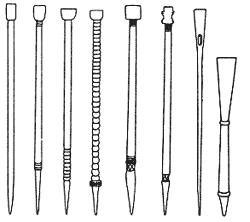
Click on the image for a larger version.
|
Image
details:
Drawing of styli found at Vindolanda
Image ownership:
© Vindolanda Trust |
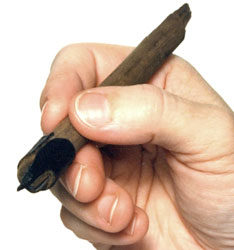
Click on the image for a larger version.
|
Image
details:
A nib excavated at Vindolanda, fitted on its orginal wooden shaft. Several words could be written with each dip of the pen.
Image ownership:
© Vindolanda Trust |
The writing instrument for the wax tablets was a metal rod, the
stylus, pointed at one end and blunt at the other for smoothing
the wax. Styli were normally plain but could sometimes be highly
decorated, the decoration perhaps allowing a more secure grip. They
could be made of metal, both bronze and iron (and occasionally precious
metals), or bone. Over 200 styli were excavated from pre-Hadrianic
Vindolanda, mostly iron. Iron objects are usually poorly preserved
on archaeological sites but conditions at Vindolanda caused styli
to be unusually well-preserved, leaving surface decoration clearly
visible. Writing in ink could use reeds, quills or iron nibs. A
small number of possible examples of the latter were found during
the excavations. They would have been fitted on wooden shafts.
Glass, ceramic and metal inkwells have also been identified. The
commonest type of inkwell was produced in the repertoire of samian
vessels, a glossy red fineware imported from Gaul. Excess ink could
be wiped from the pen into the runnel around the rim. The pot had
an internal lip to prevent ink being spilled if the well was knocked
over.
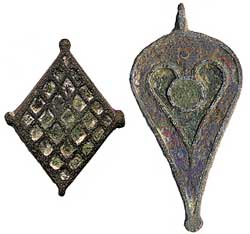
Click on the image for a larger version.
|
Image
details:
The lids of two seal boxes, with traces of
the enamel with which they were decorated
Image ownership:
Portable Antiquities Scheme |
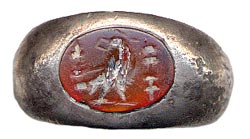
Click on the image for a larger version.
|
Image
details:
A carnelian intaglio still set in its ring,
cut with an image of an eagle with a standard on either side
Image ownership:
Portable Antiquities Scheme |
Intaglios, carved gems set in signet rings were pressed into the
sealing wax on the tie cord for booklets of stylus tablets to identify
the sealer. Moulded glass paste copies were an alternative to gems.
Often bearing images of deities, they also had potential amuletic
properties. For example a large group comes from the drains of the
legionary bathhouse at Caerleon, Wales. Bathing soldiers had lost
the rings that they wore to protect themselves from the malign spirits
to which their naked state made them vulnerable. The seal boxes
that protected the wax seal from damage, sometimes highly decorated,
are also common archaeological finds.
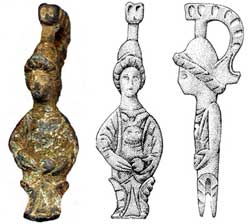
Click on the image for a larger version.
|
Image
details:
Photo and drawing of front and side view
of a bust of the goddess Minerva, the handle for a wax spatula
Image ownership:
Portable Antiquities Scheme |
New types of writing-related tools continue to be identified by
archaeologists. For example a tool with a handle in the form of
a bust of the goddess Minerva has been recently identified as an
unusual type of spatula for smoothing wax or spreading it onto tablets.
|